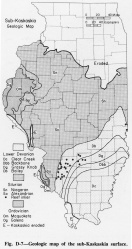Middle Devonian Series
Chronostratigraphy: Paleozoic Erathem >>Devonian System >>Middle Devonian Series
Primary source
Willman, H. B., Elwood Atherton, T. C. Buschbach, Charles Collinson, John C. Frye, M. E. Hopkins, Jerry A. Lineback, and Jack A. Simon, 1975, Handbook of Illinois Stratigraphy: Illinois State Geological Survey Bulletin 95, 261 p.
Contributing author(s)
Charles Collinson and Elwood Atherton
Name
Original description
The term "Middle Devonian Series" has been commonly used in Illinois since 1925 (Bassett).
Derivation
Other names
Previously the New York terms "Ulsterian," "Erian, " and "Senecan" were used for these rocks.
History/background
Type section
Type location
Type author(s)
Type status
Reference section
Reference location
Reference author(s)
Reference status
Stratigraphic relationships
In Illinois the Middle Devonian Series includes strata from the base of the Grand Tower or the Wapsipinicon to the top of the Alto or Cedar Valley Formations (fig. D-11), although evidence from the conodont fauna indicates that in some places the upper boundary may lie within the upper part of the Cedar Valley and the Blocher. Lowermost Middle Devonian rocks may be absent in Illinois because of the major unconformity at the base.
Because of the sub-Kaskaskia unconformity, the Middle Devonian strata truncate Lower Devonian, Silurian, and uppermost Ordovician strata (fig. D-7).
Extent and thickness
The Middle Devonian Series underlies much of the southern two-thirds of Illinois and, although commonly less than 100 feet thick in the central and western parts, it thickens to more than 400 feet in the southeastern part (fig. D-10). It is exposed in small areas in southern, western, and northwestern Illinois (fig. D-3).
|
Lithology
A broad, gentle arch, the Sangamon Arch (Whiting and Stevenson, 1965), extended northeast-southwest across north-central Illinois (fig. D-10) and served as a barrier in the Middle Devonian seas. The formations north of the arch were long considered to be uppermost Middle Devonian or Upper Devonian and younger than the formations south of the arch (Cooper et al., 1942), but more recent studies have indicated the general equivalence of the sediments on both sides (Collinson, 1967).
The Middle Devonian Series is dominantly limestone, although it is dolomitic in some areas. The upper part grades laterally to black shale in the deep part of the Illinois Basin, and a thin sandstone or sandy limestone occurs at the base in many areas. The top of the limestone or dolomite is the top of the Hunton Megagroup.
Core(s)
Photograph(s)
Contacts
Well log characteristics
Fossils
The Middle Devonian strata are generally very fossiliferous, and the large fauna is dominated by brachiopods, corals, and conodonts, although other forms are common.
Age and correlation
As now defined, the Middle Devonian Series is based on the boundaries established in Europe and is equivalent to the Eifelian and Givetian Stages (Collinson, 1967).
Environments of deposition
Economic importance
Remarks
References
BASSETT, C. F. , 1925, Devonian strata of the Alto Pass Quadrangle: Illinois Academy of Science Transactions, v. 18, p. 360-368.
COLLINSON, CHARLES, 1967, Devonian of the north-central region, United States, in International symposium on the Devonian System: Alberta Society of Petroleum Geologists, v. 1 , p. 933-939; Illinois State Geological Survey Reprint 1968-G.
COOPER, G. A., et al., 1942, Correlation of the Devonian sedimentary formations of North America: Geological Society of America Bulletin, v. 53, p. 1729-1794.
WHITING, L. L., and D. L STEVENSON, 1965, Sangamon Arch: Illinois State Geological Survey Circular 383, 20 p.
ISGS Codes
| Stratigraphic Code | Geo Unit Designation |
|---|---|







